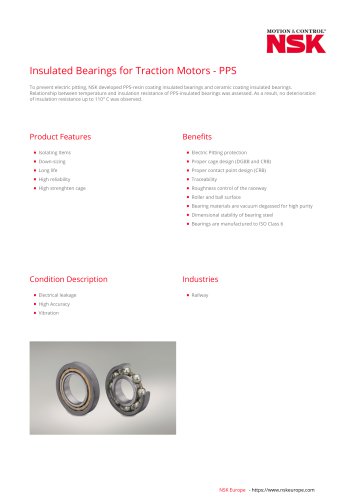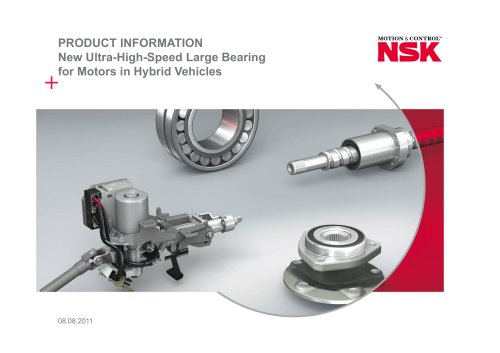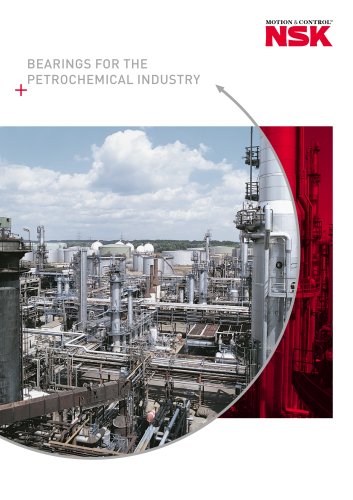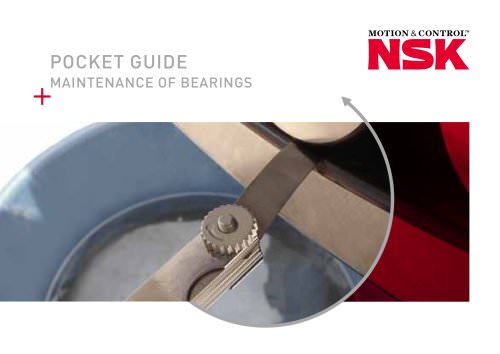 Website:
NSK Europe Ltd.
Website:
NSK Europe Ltd.
Group: NSK Group
Catalog excerpts

TECHNICAL INSIGHT A PUBLICATION OF NSK EUROPE Bearing life – Calculating the basic fatigue life expectancy of rolling bearings Bearing life is essentially the length of time a bearing can be expected to perform as required in predefined operating conditions. It is based primarily on the probable number of rotations a bearing can complete before it starts showing symptoms of fatigue, such as spalling or cracking due to stress. What determines a bearing’s service life? In addition to natural wear and tear, bearings can fail (prematurely) due to other factors such as extreme temperatures, cracks, lack of lubrication, or damage to the seals or cage. Bearing damage of this kind is often the result of choosing the wrong bearings, inaccuracies in the design of the surrounding components, incorrect installation or insufficient maintenance. Typical signs of fatigue: small, flat flakes of the bearing material become detached A standardised formula – also known as the catalogue method (ISO 281) – is the conventional means of calculating a bearing’s life. The parameters are bearing load, rotational speed, dynamic load rating and bearing type. The result is the bearing fatigue life L10 or L10h. › The Dynamic load rating (basic load rating) is defined as the constant load applied on bearings with stationary outer rings that the inner rings can endure for a rating life of one million revolutions (106 rev). The basic load rating of radial bearings is defined as a central radial load of constant direction and magnitude, while the basic load rating of thrust Average Life 1. Basic fatigue life rating L10 A bearing’s basic fatigue life rating is calculated using the number of rotations which 90% of all bearings in a specific group achieve or exceed a calculated time without failure (probability of failure: 10%). Rating Life Failure Probability and Bearing Life TECHNICAL INSIGHT · A publication of NSK Europe · www.nskeurope.com
Open the catalog to page 1
bearings is defined as an axial load of constant magnitude in the same direction as the central axis. The load ratings are listed under Cr for radial bearings and Ca for thrust bearings in the dimension tables. > The dynamic equivalent load P is defined as a mathematical radial load for radial bearings or axial load for axial bearings of a constant magnitude and direction which has the same effect on bearing life as the forces actually acting on the component. In the case of combined or constant loads, the value of P is calculated using the following formula: P = X • Fr + Y • Fa. Apart from...
Open the catalog to page 2All NSK Europe Ltd. catalogs and technical brochures
-
Ball Screws - BSS Series
1 Pages
-
Creep-Free Bearings Series
1 Pages
-
BNEQARTET Bearings
1 Pages
-
Agri Disc Hub
1 Pages
-
TF Series Bearings
1 Pages
-
Agri Disc Hub
1 Pages
-
HMS series
1 Pages
-
ROBOT MODULE™ MR SERIES
44 Pages
-
Precision Machine Components
55 Pages
-
Disc Harrow Bearings
2 Pages
-
ROLLING BEARINGS
707 Pages
-
Hub unit bearings
23 Pages
-
CONDITION MONITORING
6 Pages
-
BEARING MOUNTING TOOLS
28 Pages
-
Automotive Products
48 Pages
-
NSK IN EUROPE
6 Pages
-
Linear Guides Standard Items
62 Pages
-
Bearings for the Steel Industry
44 Pages
-
Bearing Replacement Guide
264 Pages
-
ROLLING BEARINGS
283 Pages
-
Bearings for the Cement Industry
20 Pages
-
Authorised Distributor
7 Pages
-
Added Value Training
12 Pages
-
Handling Instructions
48 Pages
-
Pocket Guide Linear Motion
44 Pages
-
Molded Oil™- Bearings
9 Pages
-
Plummer Blocks
52 Pages
-
Double Row Ball Bearing
44 Pages
-
Corporate Precision Components
24 Pages
-
Bearing Doctor
44 Pages
-
Self-Lube Hand book
160 Pages
-
Guide to RHP Self-Lube
12 Pages
-
Deep Groove Ball Bearings
12 Pages
-
Corporate Brochure
24 Pages
-
Bearings for Quarry and Mining
20 Pages
Archived catalogs
-
Troubleshooting poster
1 Pages
-
Super Precision Bearings
120 Pages
-
Ball Screw Support Bearings
44 Pages
-
Asset improvement programme
6 Pages
-
Bearings for Pumps & Compressors
24 Pages

















































































